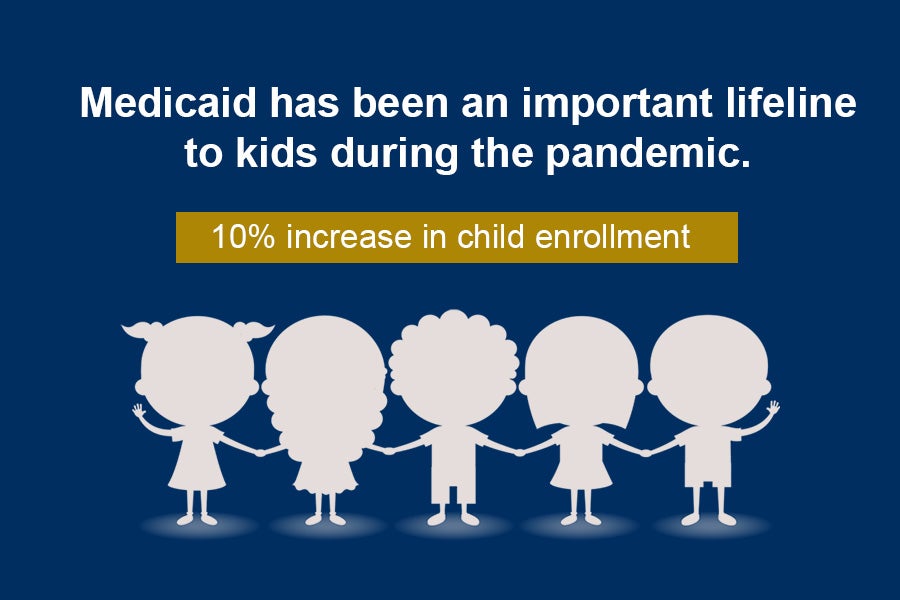The chair of the Federal Reserve, Jerome Powell, recently explained that the official unemployment statistics are too low, and that unemployment was closer to 10% in January. With the pandemic still raging and economic conditions looking very troubling, Congress is considering a COVID relief package with some important Medicaid provisions – my colleague Edwin Park blogged about them earlier this week. When unemployment goes up, so does Medicaid enrollment—and 2020 was no exception to this pattern.
A new brief from KFF based on federal CMS data reports that Medicaid enrollment increased by 8.6% between February 2020 (i.e., before the pandemic roared into everyone’s awareness) and September 2020. We and others have also been tracking Medicaid enrollment using state administrative data where we can get it because it comes out more quickly than the CMS numbers. We now have data for 30 states for December 2020 so we can look back on how enrollment changed over the course of 2020.
Examining data from February to December 2020, we see an average increase in total Medicaid enrollment of 14.8% (30 states reporting). For states where we can look at child enrollment specifically in Medicaid (not CHIP), we see a smaller but still substantial increase of 10.3% (23 states reporting).
The states with the biggest jumps in total Medicaid enrollment (20% or greater) include Missouri, Nebraska, Wisconsin, Indiana, Kentucky, and Florida. Five of the examined states have cumulative increases below 10%—Alaska, Tennessee, Maryland, Connecticut, and Arkansas.
States with the largest increase in child enrollment in Medicaid are Missouri (21.5%), Florida (16.4%), Wisconsin (14.4%), Minnesota (14.3%), and Oklahoma (13.4%). Three states have relatively low growth in their child cumulative growth under 5 percent – Alaska, Illinois, and Washington.
For a look at the data, you can view the tables here and here.
As many readers of SayAhhh! know, there is currently a Medicaid disenrollment freeze in place, so there is much speculation about how much of this enrollment increase is due to the recession and how much is due to the suspension of renewals. Astute readers of SayAhh! will notice that Missouri appears near the top of the enrollment increases both overall and for children specifically. They may also recall that Missouri was one of the states leading the way in child Medicaid enrollment declines from 2017 to 2019. The state is perhaps seeing such a large increase now because their prior procedures were causing many kids and parents to lose coverage, often inappropriately.
Another way to think about this is that states with lower Medicaid participation rates (a proxy for a lack of outreach and too much red tape) are seeing bigger increases. We know just the woman to ponder these issues more deeply – and her name is Tricia Brooks – and she will do so in a future blog.
Another factor at play is Medicaid expansion status. In Nebraska, expansion was implemented in October 2020, which is great news for those now eligible for health insurance in the middle of the pandemic and clearly contributing to their overall increases in enrollment. In Oklahoma, where voters have opted to expand Medicaid to low-income adults, but the program is yet to be implemented, there has been a large increase in child enrollment – very interesting. Finally, in Florida and Texas, two states that have not expanded Medicaid for low-income adults yet, child enrollment has increased at a faster pace than overall enrollment.
There is no definitive data yet to answer the question precisely on how much of the increase is due to economic factors v. red tape issues and the disenrollment freeze. No doubt both are at play. It seems unlikely that a lot of low-income families are seeing their incomes rise substantially during this recession, meaning most kids are likely still eligible regardless of the disenrollment freeze.
In any event, there remains a great deal of variability with respect to the level of enrollment growth that states are seeing. As the disenrollment freeze is likely to continue through January 2022 at least, and the economic recession will likely last much longer, we will continue to keep a sharp eye on enrollment trends. For now, we know that millions more children and families are getting Medicaid coverage that can provide them access to critical services they need to weather the pandemic and protect them from the financial stress of medical debt.


